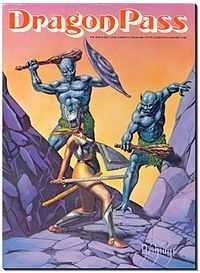White Bear and Red Moon

White Bear and Red Moon is a fantasy board wargame set in the world of Glorantha, created by Greg Stafford and published in 1975. Stafford set up the Chaosium game publishing company solely to produce and market the game.[1]
The game depicts the wars between the mighty Lunar Empire and the barbarian nation of Sartar, led by Prince Argrath, with many smaller countries and individuals available as allies to either side. The game shares a number of similarities with other games of the board wargame genre, such as a hex map, a large number of cardstock unit counters, and a number of rules themes.
White Bear and Red Moon went through three printings with minor differences. It was substantially revised and republished in 1981 under the name Dragon Pass, first by Chaosium and then in a nearly identical reprint from the Avalon Hill Game Company in 1983. The main differences in the reprint are a few streamlined rules and a notable improvement in the quality of the components. In particular the paper map was replaced by a full-colour game board. All editions are now out of print, and moderately valuable to a collector. A French language edition was published by Oriflam under license from Chaosium under the name La Guerre des Héros in 1993. A Japanese language edition was published by Hobby Japan.
Nomad Gods is another Chaosium board game that shares many rules in common, is set in a neighbouring region of Glorantha, and can be regarded as a sequel of sorts. A planned third game in the series was never produced.
Components
The game components for the Dragon Pass version of this game include the box, a fold-out board map of the battle area, the rulebook, two sheets of die-cut cardboard counters, a player aid card, and a die. The game board is 22" × 31" and printed in color. The map is overlaid by a hex grid to regularize movement. At one end of the board is a turn track and several holding boxes for magical spirits and agents.
The map includes a variety of different terrain types, including forest, marsh, hills, mountains, fortresses, stockades, ridges, cities, ruins, and lakes. Each type of terrain has different effects on movement and combat. There are also roads, rivers, and fords that can alter the movement. The map is also divided up into several territories, including a number of independent nations.
This game features a great variety of unit types and nations, forming a colorful array of unit counters with a somewhat complex system of ratings and symbols. Some units represent troops, while others are individual heroes, spirits, or agents.
Game play
An unlimited number of units can be grouped together in the same hex to form a stack. Depending on the components of the stack and how it is ordered, most stacks exert a zone of control into the surrounding hexes. Units must cease movement upon entering an enemy zone of control, and a unit can not move directly from one enemy zone of control to another. Stacks that are currently disembodied do not exert a zone of control.
Each active player's turn consists of the following phases:
- Move those units that are subject to random movement.
- Attempt to gain allies.
- Move any friendly units, and add replacements and reinforcements.
- Use any exotic abilities (such as magic).
- Resolve combat.
- Rally units that are disrupted.
Resolution of combat can include various types of magic, the use of missile fire, and finally melee combat. The combat results are in the form of Combat Factor losses, which is one of the ratings on the counters.
As is typical of many wargames, every friendly unit that is adjacent to an opposing unit must attack an adjacent opposing unit. Also each opposing unit adjacent to a friendly unit must be attacked. The exception to this is a unit inside a fortification, which is not forced to attack.
This game includes a considerable amount of chrome, simulating the variety of heroes, creatures, and magic that were involved in the battles. This can be an appealing factor to those who enjoy games with a fantasy atmosphere. Heroes and superheroes can have a powerful impact on the outcome of the various battles. The extra details can add complexity to what would otherwise be a relatively simple board wargame.
References
- ↑ Shannon Appelcline (2006-09-04). "Brief History of the Game #3". RPGnet. Retrieved 2007-09-14.